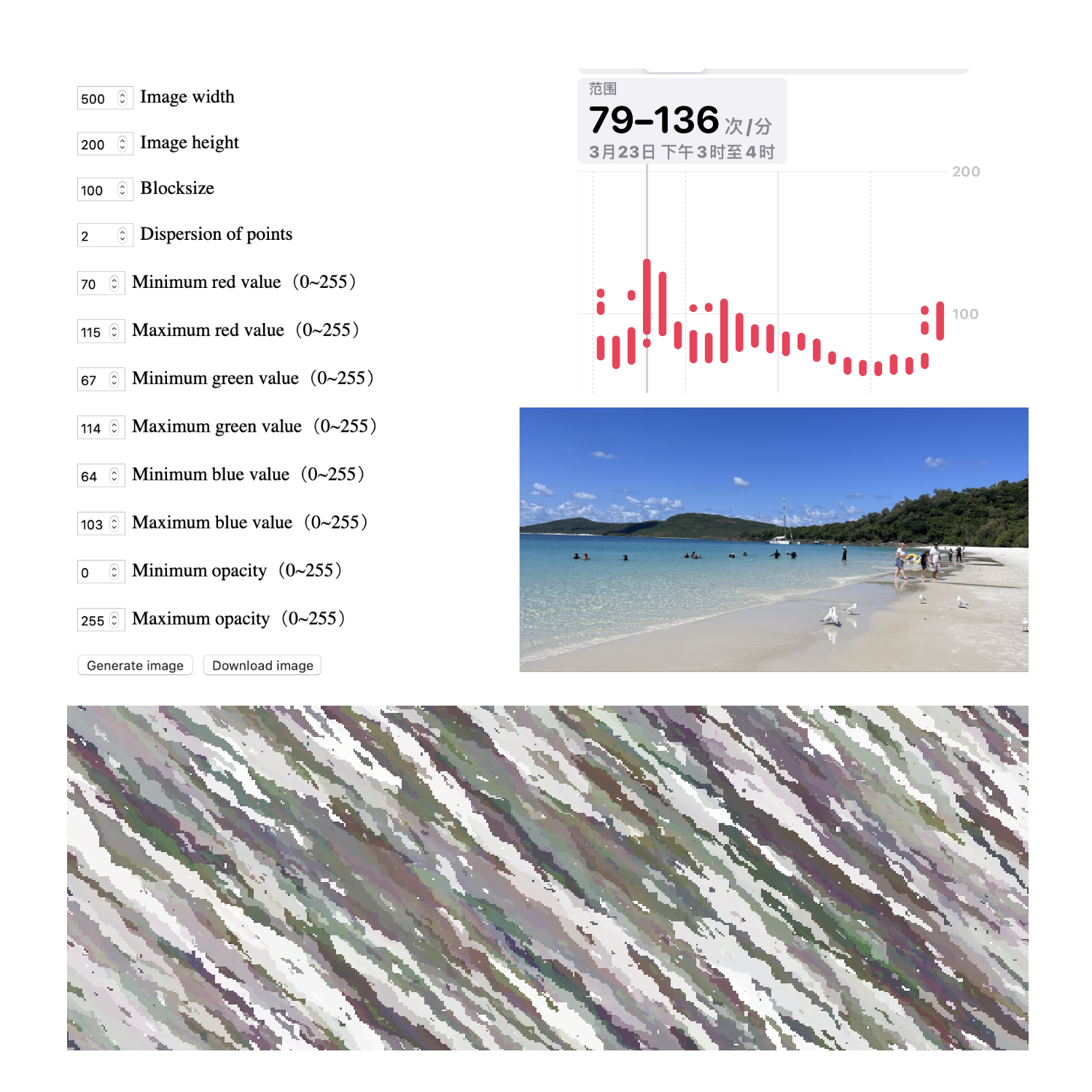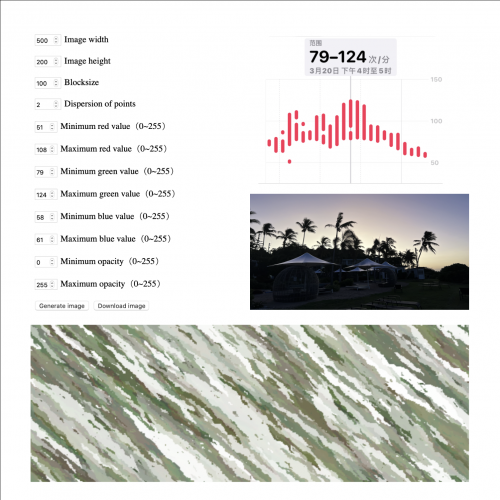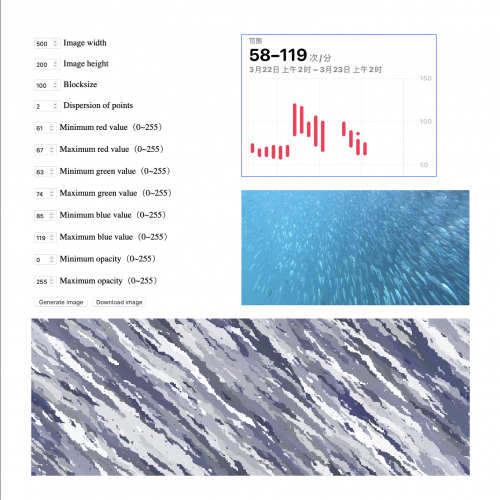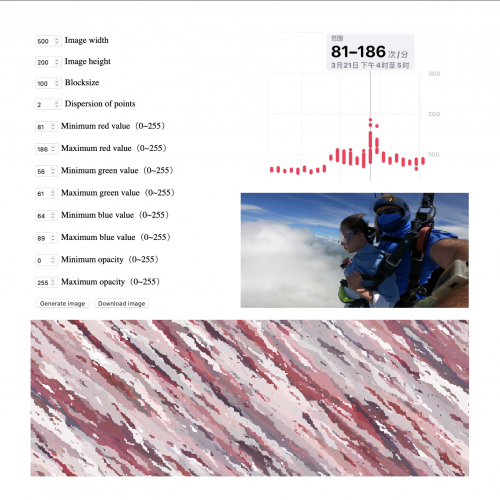
APD week 4 - Play and Place
Theme:
In response to the theme of Play and Place, I decided to try something a little different. I'll keep track of my heartbeat in some unusual or amazing places. These heartbeat values were then entered into the code of a random color image to create some unique color images that would record my feelings and memories at that location.
Context:
When people talk about a place, the first thing that comes to their mind is the memory of that place if they have been there before. If people have never been to that place, their most intuitive impression will be based on photos of the location. Is there anything else that can replace people's perceptions of a place? For example, the feelings and emotions that arise when visiting a place.
When people see a high bridge, what do they think? When people see a canyon, what do they think? When people see the sea, what do they think? Everyone's thoughts and emotions will be different. A cautious and introverted person will be stagnant in a strange place, just as an extroverted and enthusiastic person will be very exciting to explore in a strange Place. So, is it possible to record a location with emotions? And the heartbeat is the simplest and most intuitive way for me to record and express it. So I decided to go to some new places and record my heartbeat, which is my emotion. And make the heartbeat as the random color image code within the value.
Color is an extremely effective communication tool that can be used to signal action, influence mood, and even influence physiological reactions. Do you get anxious when you walk into a yellow room? Do you find the color blue to be calming and relaxing? "Colors, like features, follow the changes in emotions," artist Pablo Picasso once said. People always have shared perceptions, such as color perception. Some people are afraid of the deep sea, while others are relaxing and enjoying it. Then, using another image, record people's memories of the new places with colors and emotions.
This inspiration comes mainly from Taco Chen, the creator of Fourdesire, who stated in his book "Playful Design" that he believes in people should abstract concrete things. Instead of figurative representation, Pablo Picasso and Viktor Nizovtsev leave the paint undefined, people still feel the emotion to stimulate creativity and imagination in their own way. To abstract a concrete place into an emotion, so that others can feel the emotion brought to me by this place rather than just a photograph.
Method:
To ensure the experiment's accuracy, I decided to go somewhere I had never been before. This will prevent a situation in which the heartbeat data is very average due to familiarity. And take on some difficult places I've never been to before, such as 15,000ft skydiving and diving. Equipment I used a watch that can detect heartbeats and record them with a phone shot.
Then comes the part of writing the code. The code is based on Martin Ender and Ouuan's code to generate a completely random color image by adjusting the maximum and minimum values of red, green, and blue, as well as other values.
In the last step, edit the process and outcome video and done.
Reflection:
This theme was difficult for me. When I first considered what I wanted to do for Play and Places, I had a lot of ideas come to mind. But in the end, I went with this one. A place can be a place where you can let your ideas free or a place where you can confine yourself. People's perceptions of a place are largely determined by their personalities. Just as some people prefer to stay at home and enjoy their alone time rather than go on a trip, some others will be upset when they are forced to stay at home due to the Covid-19. So this idea of mine stems primarily from a type of cognitive Play. To represent and express the cognitive aspects of this place in an abstract way.
I chose to visit the Whitsunday Islands in Queensland as our family trip, which I had never been there before. The scenery is incredibly beautiful, and the climate is pleasant. The most important aspect is that I can have some very extreme feelings, such as skydiving and sea diving. Alternatively, just simply lie on the beach and enjoy the sand and sea breeze. It's especially interesting to see how the heartbeat accelerates when I watch other people skydive and then the heartbeat slows down after I actually jumped from the helicopter. Skydive is not as frightening as a person might think, and there is a strong feeling like fear of death at the start. However, in the moment of jumping, this feeling will be replaced by relief and release. On the dive, there was a similar sense of contrast, as I expected to be blown away by the beautiful coral and spectacular fish until I dove in. A dead white reef, an infinite blue. I felt as if I had drowned in the sea, and a sense of lost and suffocation overcame me. Only by diving deep into the sea can understand why people are afraid of the sea. Overall the beautiful scenery and exciting experience will add something unique to the project's outcome.
Of course, follow-up was essential. After deciding on the concept, I went online to look for tutorials. Fortunately, I ended up in Tweetable Mathematical Art in Code Golf, where I saw people sharing ideas and methods for doing this. Many creative and interesting ideas were shared by a wide range of people. This project's production process was a lot of fun for me!
Outcome Process:
https://www.youtube.com/watch?v=uhleswK_VM4
References:
Chen, T. (2020). Playful Design: Play and design should be interesting, Taipei: Prophet Press
Cherry, K. (2020). Color Psychology: Does It Affect How You Feel? [online] Available at <https://www.verywellmind.com/color-psychology-2795824>
Berghe, L. V. D. (2019). Color of Place: Julieanne Kost’s Color Palettes from around the World [online] Available at <https://blog.adobe.com/en/publish/2019/02/20/color-of-place-julieanne-kosts-color-palettes-from-around-the-world>
Ender, M. (2014) Tweetable Mathematical Art: Random Painter [online] Available at <https://codegolf.stackexchange.com/questions/35569/tweetable-mathematical-art>
About This Work
By Ziqi Li (April)
Email Ziqi Li (April)
Published On: 27/03/2022



